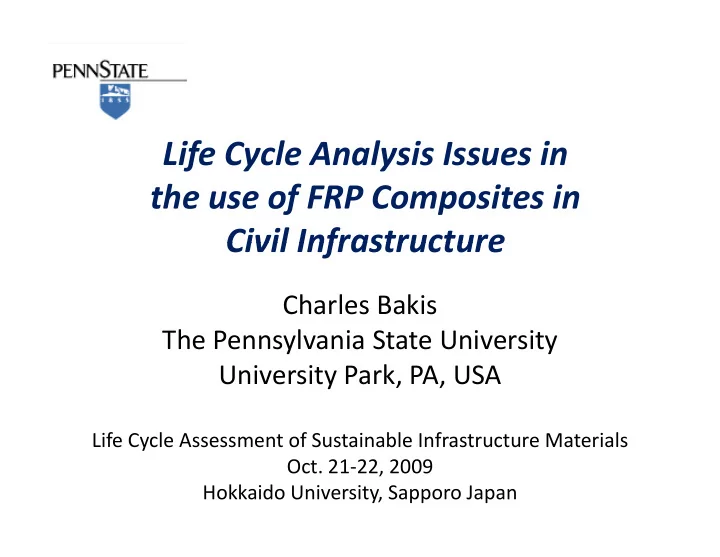

Life Cycle Analysis Issues in the use of FRP Composites in Civil Infrastructure Civil Infrastructure Charles Bakis Charles Bakis The Pennsylvania State University University Park, PA, USA University Park, PA, USA Life Cycle Assessment of Sustainable Infrastructure Materials Oct. 21 ‐ 22, 2009 Hokkaido University, Sapporo Japan
I Inputs? ? Then what? + Outputs? = How? How? (Butler Cnty. Engrs. Office, OH)
Stronger, Stiffer, Lighter...
What is inside? • Fibers – Strong, stiff Strong, stiff • Polymer matrix – Ductile; protect/support fibers ; p / pp • Fillers, veils – Cost reduction Cost reduction – Shrink & exotherm control – Flame retardant – UV protection – Surface finish & durability Cross Section
Material Design: The Boon and Bane of Composites W Ways to “lay up” composites “l ” i • Wonderful tailorability • Poor primary recyclability Quasi ‐ Quasi Isotropic (Daniel and Ishai, 1994)
Specific Strength and Modulus: “Quasi ‐ Isotropic” Composites Quasi Isotropic Composites Glass/ep 0 ‐ deg. Specific <21,0.55> <21,0.55> Tensile Strength, Carbon/ep GP /( / GPa/(g/cc) ) 0 ‐ deg. <94, 1.4> Material differences differences, residual (Based on stresses, etc. Reinhart and Clements, 1987) Specific Tensile Modulus GPa/(g/cc)
Fibers 4000 3500 3000 Carbon tress (MPa) 2500 Glass 2000 Initial Pulled Aramid 1500 1500 250 St Steel 200 1000 Force 150 0.2 → 500 100 50 0 0 0 0 0.02 0.04 0.06 0.08 0.1 0.00 0.01 0.02 0.03 0.04 0.05 Strain (m/m) Displacement • Typical fibers have high elastic deformability & T i l fib h hi h l ti d f bilit & strength, but little ‐ to ‐ no plastic deformability • Can increase deformabilit b tailoring the fiber • Can increase deformability by tailoring the fiber angle and type of matrix
Carbon Fiber Production Si Single “end,” l “ d ” or “tow” (G (Graphic source: unknown) hi k ) • Oil based, energy intensive, 25 ‐ 30 US$/kg
Glass Fiber Production Single ‐ End • Energy intensive gy • ~2 US$/kg • Multi ‐ end tows have less strength & stiffness than stiffness than single end (Graphic source: unknown)
Plant ‐ Based Fibers Plant Based Fibers • Renewable Renewable 4000 E ‐ glass Flax • Low embodied energy 3500 Hemp Kenaf Jute Abaca 3000 ( g (eg. Kenaf: 75% Sisal Sisal Coir Coir ) Stress (MPa) 2500 reduction vs. glass) 2000 • 40% less dense than 1500 S glass 1000 500 • Degradable 0 • Moisture sensitive, 0 0.01 0.02 0.03 0.04 0.05 Strain (m/m) temperature limited
Keratin Fibers Feather Fibers • Renewable Renewable • Waste product looking for a good use for a good use • 67% less dense vs. glass Quill Fiber Q • 90% less modulus and strength vs. glass • Moisture sensitive, temperature limited p (Hong & Wool, 2004)
Fillers • Natural minerals – calcium carbonate – clay • Renewable products – aluminum trihydrate y – wood flour wood flour • Manufactured – ground rice hulls products products – peanut shells t h ll – metal powder – glass beads – glass beads – phenolic powder • “The original” multifunctional filler for composites • New functions? (eg., end ‐ of ‐ service recycling?)
Matrix Materials • Thermosets (eg., polyester, vinylester, epoxy) – Good processing and cost characteristics – Cannot be thermally formed or separated from fibers • Thermoplastics ‐ eg., PET, PU – Good recycling potential, formable – Melt viscosity, bond, fatigue issues • Plant ‐ based epoxies l b d (Fulcrum Composites) – Renewable: soy, linseed – Low stiffness Lo stiffness
Manufacturing: VARTM Vacuum Vacuum Assisted Resin Transfer Molding Molding • eg., bridge decks, boats, FRP plate Resin Inlet windmill blades Tool plate (E. Strauch, Penn State U.) (D. Cripps, Gurit)
Manufacturing: Pultrusion • eg., structural shapes (Strongwell) • Pull fibers through resin and mold • Pull fibers through resin and mold • Shape and cure composite in mold (Howard Univ.) • Continuous, high ‐ speed process (cheap)
Pultruded Parts (Strongwell) (Butler Cnty. Engrs. Office, OH)
Closing Thoughts • Composites are heterogeneous, anisotropic, highly tailorable and integratable, but not amenable to primary recycling primary recycling – need good ways to utilize material post ‐ service • Connections among { environmental effects, human effects, raw material feed ‐ stocks, manufacturing ff t t i l f d t k f t i methods, material design, embodied energy, transportation costs, disposal/recycling costs, etc. } are not well described or understood t ll d ib d d t d – solutions require multi ‐ disciplinary approach – materials science, chemical engineering, mechanics, g g structural engineering, manufacturing engineering, business analysis, transportation engineering, environmental engineering, law, and climatology
Recommend
More recommend